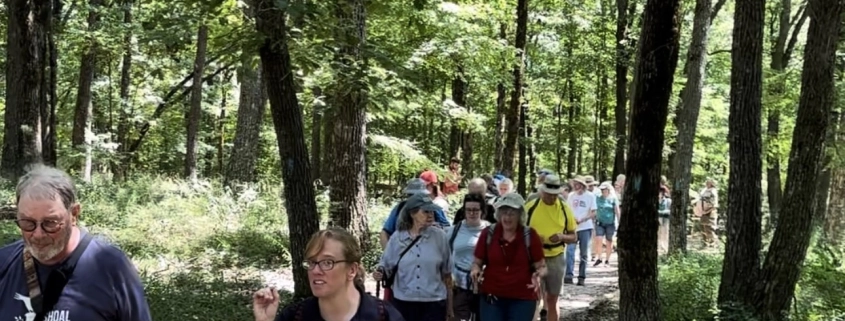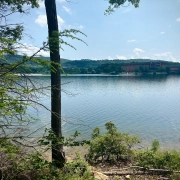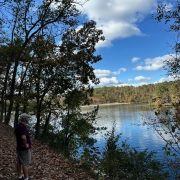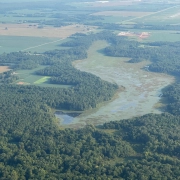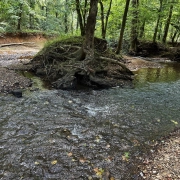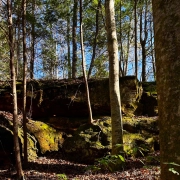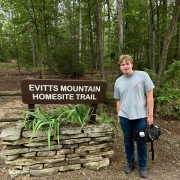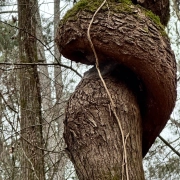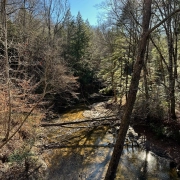Alabama Master Naturalist Field Days at Monte Sano State Park!
On Monday, June 24, 2024, I assisted Alabama State Parks Northwest District Naturalist Amber Coger in hosting a 9:00 AM to 4:30 PM Field Day at Monte Sano State Park for the Alabama Master Naturalist Program (AMNP). We hosted a second 25-enrollee Field Day on Saturday, June 29. This photo essay captures the essence of the Field Days with my observations, reflections, photos, and brief videos.
I applaud the Program’s Mission: The Alabama Master Naturalist Program strives to promote awareness, understanding, and respect of Alabama’s natural world to the state’s residents and visitors through science-based information and research.
The State Park System Mission is similar: To acquire and preserve natural areas; to develop, furnish, operate, and maintain recreational facilities, and to extend the public’s knowledge of the state’s natural environment.
My Retirement Mission resonates with both: Employ writing and speaking to educate, inspire, and enable readers and listeners to understand, appreciate, and enjoy Nature… and accept and practice Earth Stewardship.
Because of our mission overlap, I accepted an invitation six years ago to become a founding Board member of the Alabama State Parks Foundation, which has led me to publish scores of my great Blue Heron photo essays inspired by visits to our State Parks. Likewise, for reasons of mission concurrence, I enrolled in the Master Naturalist Program, successfully completing its 20 modules with a GPA of ~95, not bad for an old geezer/forester! I admit, too, to a more sentimental reason for enrolling and assisting in program delivery. From 1996 through 2001, I served as Alabama Cooperative Extension System (ACES) Director, the Mother Ship for the AMNP.
I often seek relevant quotes from great historic scientists, philosophers, artists, conservationists, and other wise forebearers. Their wisdom is timeless, as germane today as during their own era. Few would have imagined that Albert Einstein, a once-in-a-century intellect, theoretical physicist, and whimsical purveyor of human insight years ago penned what could be a tagline suited for all three entities:
Look deep into Nature and then you will understand everything better.
The mountain biker’s pavilion served as a perfect venue as our June 24, classroom.
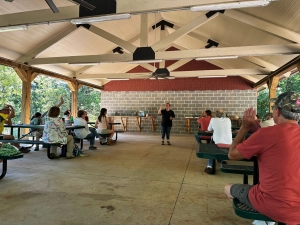
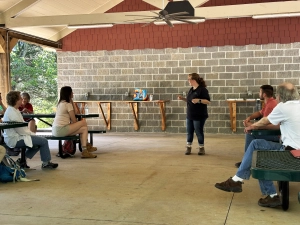
At 1,600-feet elevation, nestled within the plateau-top forest, comforted by a breeze and ceiling fans, we enjoyed learning and sharing, and meeting new friends and fellow Nature-Nerds!
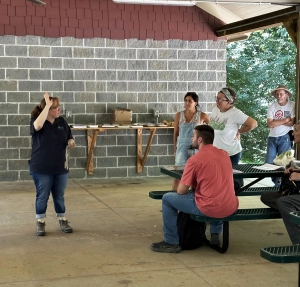
Here is my 58-second video of our group on the North Plateau Trail…not hiking, but sauntering.
John Muir abhorred the term hiking:
I don’t like either the word [hike] or the thing. People ought to saunter in the mountains – not ‘hike!’ Do you know the origin of that word saunter? It’s a beautiful word. Away back in the middle ages people used to go on pilgrimages to the Holy Land, and when people in the villages through which they passed asked where they were going they would reply, ‘A la sainte terre’, ‘To the Holy Land.’ And so they became known as sainte-terre-ers or saunterers. Now these mountains are our Holy Land, and we ought to saunter through them reverently, not ‘hike’ through them.
Sauntering the deep forest on a summer afternoon super-charges learning.
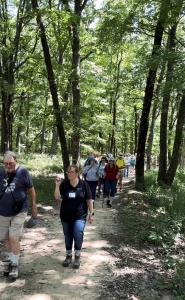
We paused frequently to identify trees and plants, answer questions, exchange stories, and enjoy scenery.
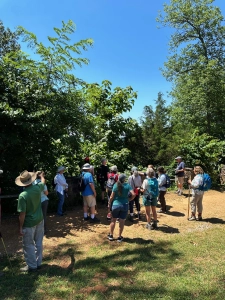
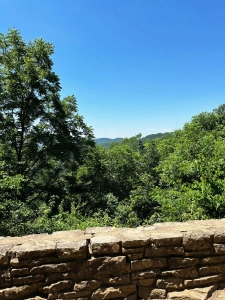
Several of us admired a dense colony of plantain-leaved pusseytoes.
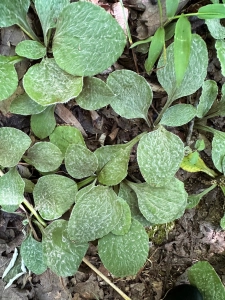
Even at sauntering pace, 25 people stretched along a single-wide path doesn’t permit the entire group to see and discuss every trailside feature, like this buttonbush. One of the common threads I weave into my writing, speaking, and forest ventures is that so much in Nature is hidden in plain sight, this fascinating flower less than ten feet from the trail serves as an example.
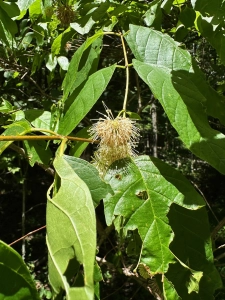
Leaves on the mid-story black gum tree nearly brushed us as we passed. I must remind myself that, if not disciplined to time, I could easily stretch a 2.5-hour saunter into 5-6 hours. I want to tell the story of every tree, flower, shrub, and curiosity along the way.
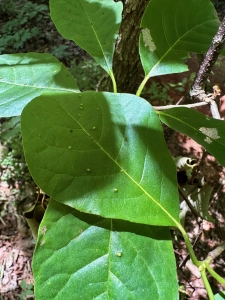
We noticed yellow buckeye saplings in several locations on June 29, showing early senescence of unknown cause. I won’t speculate.
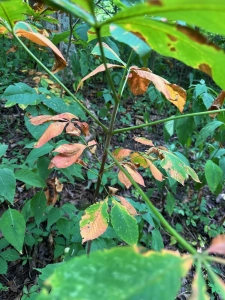
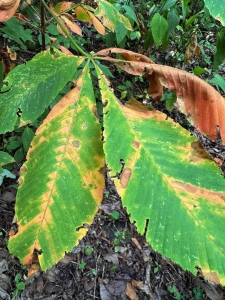
Occasionally, the trail widened to permit the entire entourage to gather, as was the case when we crossed a power line and later at the overlook.
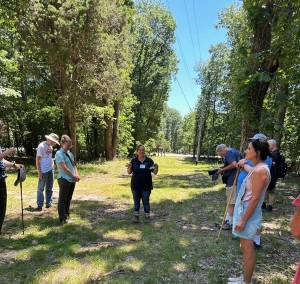
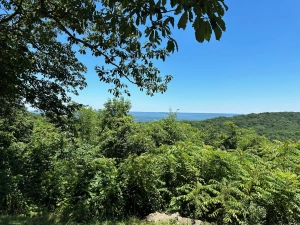
Near the Park Lodge we all coalesced to explore several features, including this serene underwing moth that fluttered from a shagbark hickory trunk, where it had blended invisibly with the tree’s bark.
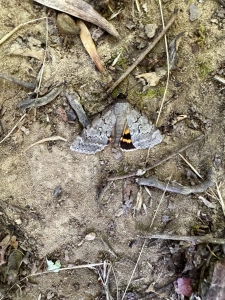
As we re-entered the forest from the overlook, me lagging with two stragglers, I spotted an ancient chestnut oak, deeply scarred by a decades-old lightning strike and worthy of recording this short video.
The old oak bore the scar from a searing lightning blast decades earlier. Such strikes can spell instant explosive death or leave a permanent non-fatal wound. Such a wound deadens a strip of the bark vertically, opening an infection court for wood decay organisms that begin their inexorable consumption of the mighty oak from within. The hollow oak will eventually yield to forces of wind and gravity. The rule of thumb is that the tree will topple when the persistent sound wood rind thickness falls below a third of the tree’s diameter at any given point. Can we then attribute the cause of death to lightning? The tree doesn’t care. The cause will be a matter of concern and interest to only a few old foresters and a handful of eager Master Naturalists.
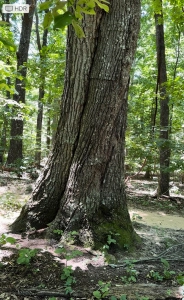
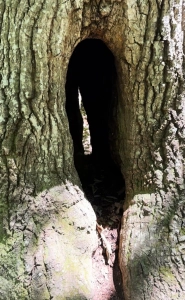
Black locust is rapidly exiting the plateau forests of Monte Sano State Park. An early successional species, black locust likely dominated the younger forest of the 1970-1990s. The black-capped polypore pathogen infects most of the remaining locusts, signaling the trees’ demise with its distinctive shelf fruiting body.
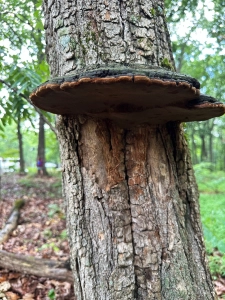
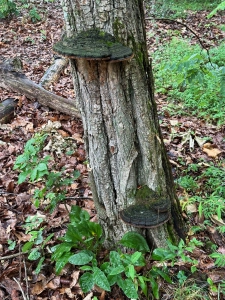
Arthropods
A Master Naturalist knows about all manner of life, including the insects and diverse organisms that constitute Nature’s full ecosystem tapestry. Amber directed participants through an exercise intended to discover life forms residing in shrubs and under logs, leaves, and brush.
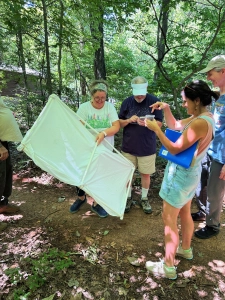
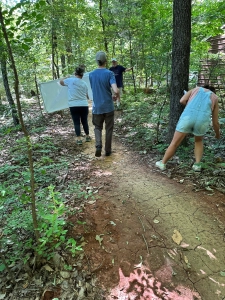
Here is my 37-second video of the June 29, arthropod bush-beating exercise:
Field Day participants undertook their task with relish and enthusiasm.
Forest Bathing
Amber introduced participants to the Japanese practice of shinrin-yoku, also known as forest bathing, a form of therapeutic relaxation where one spends time in a forest or natural atmosphere, focusing on sensory engagement to connect with Nature. Each person found a location near the pavilion to seek personal connection. Some chose a bench, leaned against an oak trunk, or chose a grassy spot to lie face-up.
I secured anchorage on an old stone wall (rich with diverse lichen crusting) under the combined shade of a chestnut oak and an adjacent black walnut tree.
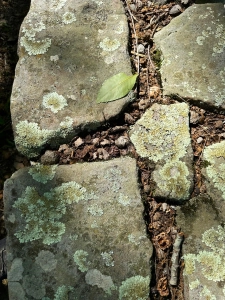
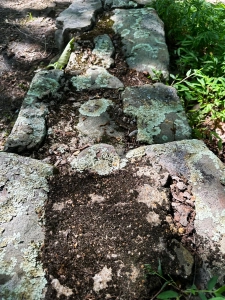
The canopies gently swayed under the deep blue firmament. I recorded this 60-second video of the medium in which I soaked…soothing and immersing my body, mind, heart, soul, and spirit.
The view directly above me reminded me that all living creatures, whether the trees reaching high or the serene underwing moth we encountered earlier, draw life-energy from the star around which we orbit.
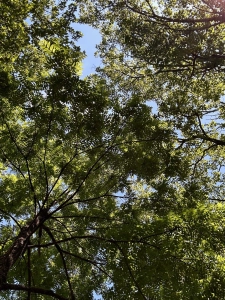
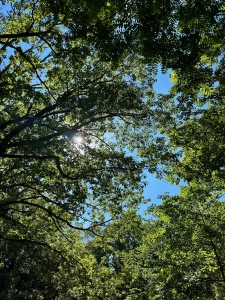
A different kind of forest bathing visited the Monte Sano Lodge on June 29, as Amber lectured indoors. I captured the summer shower with this 60-second video:
The brief shower quickly drifted to our south.
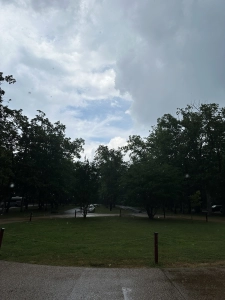
Closing Reflections
I thought of the deep revelation that John Muir shared as he contemplated the never-ending cycle of life on Earth:
It is always sunrise somewhere; the dew is never all dried at once; a shower is forever falling; vapor is ever rising. Eternal sunrise, eternal sunset, eternal dawn and gloaming, on sea and continents and islands, each in its turn, as the round earth rolls.
I offered a closing charge to the participants. Louis Bromfield, mid Twentieth Century novelist, playwright, and conservationist, bought what he called his old worn out Ohio farm in the 1930s and subsequently dedicated his life to rehabilitating the health of its land and soils. He tells the story of his passion-driven land-healing in his non-fiction Pleasant Valley (1945):
The adventure at Malabar is by no means finished. The land came to us out of eternity, and when the youngest of us associated with it dies, it will still be here. The best we can hope to do is to leave the mark of our fleeting existence upon it, to die knowing that we have changed some small corner of this Earth for the better, by wisdom, knowledge, and hard work.
I implored the fledgling Master Naturalists to view their own responsibility to:
promote awareness, understanding, and respect of Alabama’s natural world to the state’s residents and visitors through science-based information and research.
I encouraged them in their own way, to leave the mark of their fleeting existence upon the land and the people they touch…to change some small corner of the Earth for the better, by wisdom, knowledge, and hard work.
As I do with all audiences, I reminded them that people don’t care how much you know…until they know how much you care. Like all worthy conservationists, whether State Park Naturalists, Master Naturalists, or old worn out foresters, we operate most convincingly, effectively, and indelibly when we bring the Power of our Passion to the Service of Reason, in the cause of informed and responsible Earth Stewardship.
Alabama State Parks Foundation
Thoughts and Reflections
I offer these observations:
- I don’t like either the word [hike] or the thing. People ought to saunter in the mountains – not ‘hike!’ (John Muir)
- Look deep into Nature and then you will understand everything better. (Albert Einstein)
- We can never have enough of Nature. (Henry David Thoreau)
Inhale and absorb Nature’s elixir. May Nature Inspire, Inform, and Reward you!
Note: Unless otherwise noted, all blog post images are created & photographed by Stephen B. Jones. Please circulate images with photo credit: “©2024 Steve Jones, Great Blue Heron LLC. All Rights Reserved.”
Another Note: If you came to this post via a Facebook posting or by another route, please sign up now (no cost… no obligation) to receive my Blog Post email alerts: http://eepurl.com/cKLJdL
And Third: I am available for Nature-Inspired Speaking, Writing, and Consulting — contact me at steve.jones.0524@gmail.com
A reminder of my Personal and Professional Purpose, Passion, and Cause
If only more of us viewed our precious environment through the filters I employ. If only my mission and vision could be multiplied by untold orders of magnitude:
Mission: Employ writing and speaking to educate, inspire, and enable readers and listeners to understand, appreciate, and enjoy Nature… and accept and practice Earth Stewardship.
Vision:
- People of all ages will pay greater attention to and engage more regularly with Nature… and will accept and practice informed and responsible Earth Stewardship.
- They will see their relationship to our natural world with new eyes… and understand their Earth home more clearly.
Tagline/Motto: Steve (Great Blue Heron) encourages and seeks a better tomorrow through Nature-Inspired Living!
Steve’s Three Books
I wrote my books Nature Based Leadership (2016), Nature-Inspired Learning and Leading (2017), and Weaned Seals and Snowy Summits: Stories of Passion for Place and Everyday Nature (2019; co-authored with Dr. Jennifer Wilhoit) to encourage all citizens to recognize and appreciate that every lesson for living, learning, serving, and leading is either written indelibly in or is powerfully inspired by Nature.
I began writing books and Posts for several reasons:
- I love hiking and exploring Nature
- I see images I want to (and do) capture with my trusty iPhone camera
- I enjoy explaining those images — an educator at heart
- I don’t play golf!
- I do love writing — it’s the hobby I never needed when my career consumed me
- Judy suggested my writing is in large measure my legacy to our two kids, our five grandkids, and all the unborn generations beyond
- And finally, perhaps my books and Blogs could reach beyond family and touch a few other lives… sow some seeds for the future
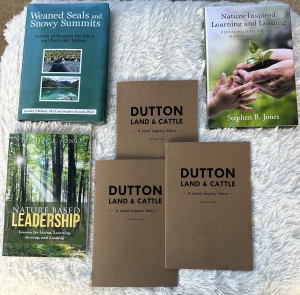
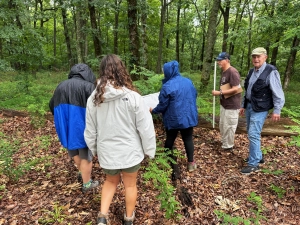
All three of my books (Nature Based Leadership; Nature-Inspired Learning and Leading; Weaned Seals and Snowy Summits) present compilations of personal experiences expressing my (and co-author Dr. Wilhoit for Weaned Seals and Snowy Summits) deep passion for Nature. All three books offer observations and reflections on my relationship with the natural world… and the broader implications for society. Order any from your local indie bookstore, or find them on IndieBound or other online sources such as Amazon and LifeRich.
I now have a fourth book, published by Dutton Land and Cattle Company, Dutton Land & Cattle: A Land Legacy Story. Available for purchase directly from me. Watch for details in a future Post.

